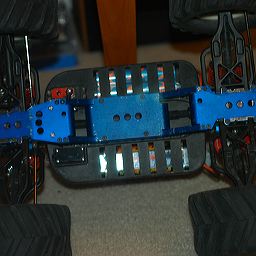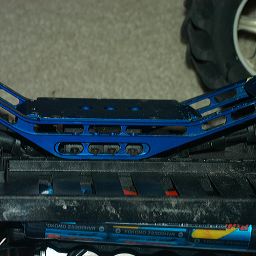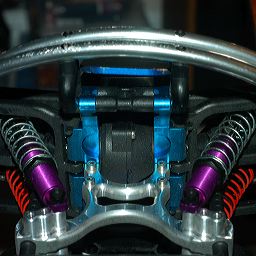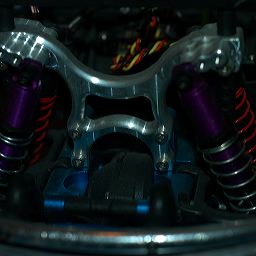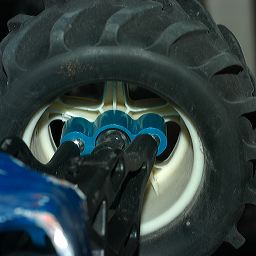Mitch Richling: E-Maxx Modifications
| Author: | Mitch Richling |
| Updated: | 2021-05-23 |
Table of Contents
1. Introduction
The E-Maxx is a very versatile monster R/C truck. As a toy, it rocks right out of the box. As a starting point for a serious R/C monster truck, it rocks. As a base platform and drive train for robotics use, it rocks. In short, you simply can't go wrong with this little truck!
I originally purchased mine to be the base of a robot, but I routinely drive it around the yard under R/C control just for the fun of it! So far I have built two different experimental electronics packages transforming this little car into a fully autonomous robot can can drive itself around the yard following squirrels and ducks while avoiding the pond. I'm currently working on the 3rd generation electronics package for this same platform! All that said, this page is about E-Maxx and R/C, so I will keep to the topic of the E-Maxx as an R/C truck, and how to get the most out of it in that respect.
2. When to buy aluminum parts…
I don't think about the E-Maxx as a "hop up" project, but as an R/C monster truck that wants to be driven hard, fly over dirt piles, and crash into yard debris. My has been repeatedly "driven hard and put up wet" over the last few years. At this point it has almost none of the original parts that came in the box left! If a part has an aluminum replacement, then I have, at one time or another, installed it at one time or another. After some hard experimentation, I have come to the conclusion that the common "make everything anodized aluminum" battle cry coming from kids at the local hobby shop is very wrong! Some parts should be replaced with tougher aluminum, while others need to be more breakable – just like real cars have crumple zones.
It is important that your E-Max have a solid aluminum frame. The framework consists of the following parts:
- Front and rear skid plate (part 4938 and ?)
- These take quite a bit of frictional abuse when the truck is driven over concrete (curbs are particularly hard) or gravel. The stock plastic parts don't last long
- Drive shaft cover (optional part 4947)
- This is an optional part many don't put on the truck, but it is a real life saver if you drive over gravel or rocks as they can easy get between the frame struts and tear up the drive shaft - which is expensive and a pain to replace.
- Front and rear bulkheads (part 4930 or 4930X)
- These take a lot of stress on rough terrain, rolls, and jumps. They are also a serious pain to replace when they break.
- Lower frame struts (part 4923 or 4923X)
- This is a must-do upgrade no matter what you use the truck for. These provide the primary connection points for the body and the wheels. The stock frame struts are strong, but not strong enough if you take the truck too high on a jump or hit a wall at full speed.
- Front and rear shock towers (part 4917 or 4917X)
- These simply take too much abuse when hitting hard after flying through the air. They frequently snap off. This is especially true if you have upgraded the shocks, or changed to a harder suspension for better cornering and control at high speed
In addition to the frame components, the following should be aluminum:
- Front and rear bumpers (part 4935 or 4935X)
- These just break too easily. That is why you see so many trucks on the track with no bumpers! Still, they provide good protection for the shocks and front wheel wish bones in a crash.!
- Steering servo skid plate
- The steering servo is very exposed, and if you drive over rock or gravel it will get destroyed. The horn frequently snaps off if you drive over the wrong thing.
- Front and rear axle carriers/steering blocks (part 4932)
- The stock plastic simply can not take the force of higher speed steering with a brushless motor on board.
Some parts should NOT be aluminum:
- Bumper mounts (part 4936)
- When the truck hits hard, the damage could be traumatic. In the worst case, the expensive frame components like the bulkheads or frame struts could be damaged. In the best case, the expensive bumper mounts or bumper will be destroyed. OTOH, if the bumper mounts are plastic, you can fix the damage for less than a dollar. The plastic bumper struts also serve as a "crumple zone" just like the ones in real cars. By allowing the strut to crush, shock impact on the rest of the truck is greatly reduced. For example, I have seen receiver boxes and motor plates ripped out in crashes involving trucks with all aluminum chassis components and aluminum bumper struts.
- Body mount posts (part 4914)
- Then a roll could damage the expensive bulkheads or shock towers. Ouch! OTOH, if the body mount posts are plastic, the cost will be minimal. If the roll was so violent, that the shock towers get damaged anyway, then you were in for some trouble anyhow – and the towers would most probably be have been destroyed anyhow.
- Wish bones
- This is a horrible prospect in a crash. They will bend, or bend your frame. If the truck hits hard enough, they can rip the bulkheads off. Bad news!
Here are some photos of the most important aluminum parts:
3. What to change on the electronics side…
On the electronics side, the stock E-Maxx can use several upgrades that will make it a stronger, faster, more controllable truck. Some of these are controversial. For example, I would rather use my stock radio transmitter on all my cars, so I always switch out the TX/RX on a new vehicle as standard practice. If this weren't the case, I might not as strongly suggest a TX upgrade at all as the one that ships with the E-Maxx is better than most RTR setups – I would still make the suggestion, just not as strongly.
- Stronger steering servo
- This is simply a must even if you leave the stock motors in the truck. The stock servo is not strong enough to get tight cornering at high speeds, and the servo will quickly deteriorate if you ride it too hard.
- Better receiver
- The stock transmitter and receiver are OK, but not fast enough to provide good control at high speeds. The best option is to upgrade to a 2.4GHz system, but even a high quality 75MHz system is better than what comes in the box.
4. Other Mechanical modifications…
The mechanical modifications in this section can be more difficult in some ways than others on this page because they involve non-standard components, hacking into the frame of the truck, and generally being a bit more destructive. That shouldn't discourage the budding E-Maxx trickster from giving these a try.
- Steering servo saver kit
- This can really help extend the life of the servo, and make stirring much more precise - especially at higher speeds. This is the easiest change in this section.
- brushless motor
- Hacker has some nice units that fit right in the stock 550 motor mounts. With just one brushless motor, the truck is a much faster. I have put two in the chassis, and that made for a crazy ride - upgrade the transmission gears if you do this!
- Rear steering
- The rear end of the E-Maxx has a similar construction to the front end, and the rear wheel may be fitted with steering control rods just like the front wheels. The rear wheels should turn the opposite way as the front wheels. For R/C control, I find the best option to have the rear steering kick in at about a half a turn on the steering wheel – so it is only used when you want to steer sharply. This can cut the turning radius of an E-Maxx in half.
